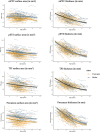Beyond the average brain: individual differences in social brain development are associated with friendship quality
- PMID: 33277895
- PMCID: PMC7943358
- DOI: 10.1093/scan/nsaa166
Beyond the average brain: individual differences in social brain development are associated with friendship quality
Abstract
We tested whether adolescents differ from each other in the structural development of the social brain and whether individual differences in social brain development predicted variability in friendship quality development. Adolescents (N = 299, Mage T1 = 13.98 years) were followed across three biannual waves. We analysed self-reported friendship quality with the best friend at T1 and T3, and bilateral measures of surface area and cortical thickness of the medial prefrontal cortex (mPFC), posterior superior temporal sulcus (pSTS), temporoparietal junction (TPJ) and precuneus across all waves. At the group level, growth curve models confirmed non-linear decreases of surface area and cortical thickness in social brain regions. We identified substantial individual differences in levels and change rates of social brain regions, especially for surface area of the mPFC, pSTS and TPJ. Change rates of cortical thickness varied less between persons. Higher levels of mPFC surface area and cortical thickness predicted stronger increases in friendship quality over time. Moreover, faster cortical thinning of mPFC surface area predicted a stronger increase in friendship quality. Higher levels of TPJ cortical thickness predicted lower friendship quality. Together, our results indicate heterogeneity in social brain development and how this variability uniquely predicts friendship quality development.
Keywords: adolescence; friendship quality; longitudinal; social brain; structural brain development.
© The Author(s) 2020. Published by Oxford University Press.
Figures


References
-
- Akaike H. (1998). A new look at the statistical model identification. In: Parzen, E., Tanabe, K., Kitagawa, G., editors. Selected Papers of Hirotugu Akaike, New York: Springer, 215–22. doi: 10.1007/978-1-4612-1694-0_16 - DOI
-
- Berndt T.J. (2002). Friendship quality and social development. Current Directions in Psychological Science, 11(1), 7–10. doi: 10.1111/1467-8721.00157 - DOI

